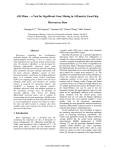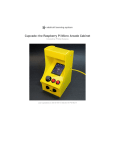Download Reconstructing Pong on an FPGA
Transcript
Reconstructing Pong on an FPGA Stephen A. Edwards Department of Computer Science, Columbia University cucs–023–12, December 2012 Abstract I describe in detail the circuitry of the original 1972 Pong video arcade game and how I reconstructed it on an fpga—a modern-day programmable logic device. In the original circuit, I discover some sloppy timing and a previously unidentified bug that subtly affected gameplay. I emulate the quasi-synchronous behavior of the original circuit by running a synchronous “simulation” circuit with a 2× clock and replacing each flip-flop with a circuit that effectively simulates one. The result is an accurate reproduction that exhibits many idiosyncracies of the original. 1 Pong Circuit Description 1.1 The Main Clock . . . . . . . 1.2 The Horizontal Counter . . . 1.3 The Vertical Counter . . . . 1.4 Horizontal and Vertical Sync 1.5 The Net . . . . . . . . . . . . 1.6 The Paddles . . . . . . . . . . 1.7 The Score . . . . . . . . . . . 1.8 Horizontal Ball Control . . . 1.9 Vertical Ball Control . . . . . 1.10 Video Generation . . . . . . 1.11 Sound . . . . . . . . . . . . . 1.12 Game Control . . . . . . . . . . . . . . . . . . . . 2 2 2 5 5 7 7 9 11 15 17 17 19 2 Reconstructing Pong on an FPGA 2.1 Handling Quasi-Synchronous Circuits . . . . . . . . . . . . . . . . . . . . . . 2.2 A Minimal Hardware Description Language . . . . . . . . . . . . . . . . . . . 2.3 I/O on the Terasic de2 board . . . . . . . . . . . . . . . . . . . . . . . . . . . . 21 21 22 25 3 Conclusions 26 . . . . . . . . . . . . . . . . . . . . . . . . . . . . . . . . . . . . . . . . . . . . . . . . . . . . . . . . . . . . . . . . . . . . . . . . . . . . . . . . . . . . . . . . . . . . . . . . . . . . . . . . . . . . . . . . . . . . . . . . . . . . . . . . . . . . . . . . . . . . . . . . . . . . . . . . . . . . . . . . . . . . . . . . . . . . . . . . . . . . . . . . . . . . . . . . . . . . . . . . . . . . . . . . . . . . . . . . . . . . . . . . . . . . . . . . . . . . . . . . . . . . . . . . . . . . . . . . . . . . . . . . . . . . . . . . . . . . . . . . . . . . . . . . . . . . . . . . . . . . . . . . . . . . . . . . . . . . . . . . . . . . Introduction This work started with a desire to play Pong, Atari’s 1972 video arcade game that effectively launched the industry [11]. While I could have sought out one of the few remaining machines, I chose instead to reconstruct it on an fpga, much as I had done for the Apple II computer [7] and others have done for various other classic video arcade games [8]. Pong and other early games were implemented largely with discrete ttl chips, hence my choice of an fpga. By contrast, most later games were processor-based and have been successfully emulated in software using an instruction-set simulator interacting with a highlevel ad hoc simulator for the video hardware [9]. While modern processors are vastly faster than the roughly 7 MHz clock frequency of Pong and many have written Pong-like programs in software, my goal was precise (cycle-accurate) emulation. I ruled out doing so in software because I expect it would be difficult to implement a software circuit simulator able to consistently run this fast. However, while the Pong circuit is ostensibly synchronous, it is actually littered with ripple counters, rs latches built from discrete nand gates, and flip-flops clocked from combinational logic, all of which are anathema to robust fpga designs. Below, I describe the circuit of the original Pong with a focus on its timing and analog components (§ 1), then describe my technique for reconstructing it on a modern-day, fully synchronous fpga (§ 2). 1 Pong Circuit Description In addition to reading the schematics for Pong that can be found online (they appear to have been scanned from service manuals), Dan Boris [4] presents an extensive description of the circuit; much of what I write here is derived from his work, especially his division of the circuit into sections. Arkush [15] also describes part of the circuitry in Pong, focusing closely on how counters are used to control the position of the ball. 1.1 The Main Clock Figure 1 shows the main clock generator: a 14.318 MHz crystal oscillator1 driving a nand gate driving a jk flip-flip that halves the frequency and generates a 50% duty-cycle square wave: the 7.159 MHz master clock. 14.318 MHz is a common crystal frequency in video circuits because it is four times the ntsc colorburst frequency of 315/88 MHz = 3.579545 MHz. Pong, however, is black-and-white so another frequency could have been used. 1.2 The Horizontal Counter The horizontal counter (Figure 2), built from two 7493s (f8 and f9) and a 74107 (f6), keeps track of the horizontal position of the video beam. The 7493 is a four-bit ripple counter built from four negative-edge-triggered t flip-flops. 1 The frequency is not labeled on the schematic, but multiple sources, including schematics of Pong clones, confirm this value. 14.318 MHz 100pF 330 Ω 330 Ω 11 C9e 10 0.1 µ F 9 7404 C9d 8 7404 12 E6d 13 7400 11 1 3 1 J Q 12 F6a 4 74107 2 1 K Q 13 CLK 1 Figure 1: The main clock oscillator. This generates a 7.159 MHz square wave. Abstractly, the eight-input nand f7 detects the count 256 + 128 + 64 + 4 + 2 = 454 and causes the counter to reset, but the behavior is slightly more subtle, as shown in Figure 4. Because the ripple counters are triggered on the negative edge of the clock but the output of f7 is buffered by the positive-edge-triggered d flip-flip e7b, the count 454 is only seen for half a clock period while the count 0 is seen for one-and-a-half clock periods because the hreset signal only rises after the next rising edge of the clock, effectively surpressing the count on the next falling edge of the clock. The period of hreset is thus 7.159 MHz/455 = 15.734 kHz, exactly the ntsc horizontal frequency. The horizontal counter is one of the most active parts of the circuit, yet Alcorn used slower, more problematic ripple counters instead of synchronous counters. Why he did this is not clear; one hypothesis is that it was a cost-saving measure: 7493s were nearly half the price of 74161s in 1975 [10]. The use of ripple counters in the horizontal timing circuitry of these games appears to be characteristic of Alcorn. Bushnell’s earlier, more complex, and far less successful Computer Space (Nutting Associates, 1973) did use 74161s [12]. Alcorn designed [6] Atari’s 1973 successor to Pong, Space Race [11], and again used 7493s [3]. Atari’s 1974 Pin Pong, not designed by Alcorn, used synchronous counters (9316s) [2]. The presence of ripple counters makes the timing of this circuit worth discussing. In Figure 2, I drew some of the internal structure of the counters to help explain the behavior of this circuit. The outputs 1h...256h do not change simultaneously: they ripple, which can be problematic for decoding particular columns. To decode 454 as needed, fortunately, the delay is effectively modest because it is triggered by 2h going high, which occurs only two flip-flop delays after the falling edge of the 7.159 MHz clock—all the other signals went high in a previous cycle and stay stable just before reaching a count of 454. CLK 14 3 7493 12 2 F8 1 9 8 11 14 3 7493 12 2 1 F9 9 8 1 8 5 J Q 9 F6b 11 74107 6 K Q 256H 10 11 1 256H 128H 64H 32H 16H 8H 4H 2H 1H 1 11 12 5 F7 6 7430 2 3 4 10 812 9 D Q 11 E7b 7474 8 Q HRESET HRESET 13 Figure 2: The horizontal counter: This counts 0, 1, . . . , 454, generating a 15.734 kHz horizontal frequency. HRESET 14 1 3 2 3 2 R02 R01 R02 R01 14 CKA E8 CKA E9 1 CKB 7493 CKB 7493 QA QB QC QD QA QB QC QD 12 9 8 11 12 9 8 11 1 8 5 J Q 9 D9b 11 74107 6 K Q 256V 10 9 10 D8c 11 7410 4 82 5 D Q 3 E7a 7474 6 Q 1 256V 128V 64V 32V 16V 8V 4V 2V 1V Figure 3: The vertical counter: This counts 0, 1, . . . , 261 1 VRESET VRESET CLK 7M 1H-256H 451 452 453 454 0 2 3 HRESET HBLANK 1V-256V 261 0 VRESET 1V-256V 0 1 1 2 VRESET 1V-256V VRESET Figure 4: Behavior of the horizontal and vertical counters at the end of a horizontal line 1.3 The Vertical Counter The vertical counter (Figure 3) is similar to the horizontal counter, but is clocked once per field by the hreset signal generated by the horizontal counter and resets on a count of 1 + 4 + 256 = 261. This gives a vertical refresh frequency of 15.734 kHz/262 = 60.05 Hz, which is certainly close enough to 60 Hz for most monitors. A strictly compliant (interlaced) ntsc signal actually has 525/2 = 262.5 horizontal line periods per field. Again the 7493s are negative-edge triggered, so the vertical count changes when hreset falls and is reset when hreset rises—see Figure 4. 1.4 Horizontal and Vertical Sync Figure 5 shows the circuits for generating horizontal and vertical blanking and synchronization signals. These are two rs latches built from discrete gates with some extra gating logic. Part of the timing of the horizontal blanking latch is problematic. The hreset signal is not a problem because it comes directly from a flip-flop triggered by the clock (e7b, see Figure 2, so hblank falls quickly after the rising edge of the clock. However, for hblank to rise, 64h must be high and nand g5b looks for the rising edge of 16h (a count of 64 + 16 = 80). This is initiated by a falling edge on the 7 MHz clock and occurs after passing through five flip-flop stages (all of the f8 ripple counter and the first stage of f9). Below is an accounting of delays based on numbers from ti’s 1988 data book [14]. 16H 64H 3 4 G5b 5 7410 HRESET 64 H5b 5 7400 6 9 H5c 10 7400 8 32H VRESET 16V 8 9 F5c 10 7402 11 12 F5d 13 7402 4V 8V 1 H5a 2 7400 3 HBLANK 12 H5d 13 7400 HBLANK 11 HSYNC VBLANK 1 2 G5a 13 7410 VBLANK 12 VSYNC Figure 5: Horizontal and Vertical Blanking and Sync CLK 7M 1H-256H 77 78 79 80 81 82 HBLANK Figure 6: Behavior of hblank near the start of the line. Because of the ripple counters in the horizontal counter, hblank rises after the next rising edge of the clock. Path Typ. Max. clk falling to 8H falling 8H falling to 16H rising 16H rising to G5b-6 falling G5b-6 falling to hblank rising 46 ns 10 7 11 70 16 15 22 clk falling to hblank rising 74 123 However, the 7 MHz clock has a period of about 140 ns, meaning hblank rises after the next rising edge of the clock. Figure 6 illustrates this. hsync only goes low when hblank is low (horizontal counts 0–79) and 32h is high, i.e., from horizontal counts 32 to 63 inclusive. Using similar reasoning, vblank goes low when vreset goes high: during line 0, and high again at the start of line 16. vsync is only low when vblank is low, 4v is high, and 8v is low: lines 4 through 7 inclusive. VBLANK V4 256H CLK 256H 4 G3b 5 7400 5 8 J Q 9 F3b 11 74107 6 K Q 10 6 3 4 5 G2b 6 7427 NET 1 Figure 7: Circuit that generates the net 1.5 The Net The net is a simple graphic object—a dashed line going down the center of the screen—that does not affect gameplay. Figure 7 shows the circuit, which displays a vertical line in column 256 that alternates between four pixels on and four pixels off. Before the horizontal counter reaches 256, 256h is low and 256h is high, so f3b’s q is high. When the horizontal counter reaches 256, 256h goes high, sending the output of g3b low, enabling g2b to pass v4 as the net signal when out of vertical blanking. In the next cycle, since 256h was high and 256h was low, f3b’s q falls, setting net low. 1.6 The Paddles Figure 8 shows the circuit generating the signals that indicate when (and hence where) each player’s paddle is displayed. There are two identical circuits, one for each player. Each 555 is wired as a one-shot triggered near the bottom of the screen; the paddle sets the delay time, controlling on which line the one-shot expires. Player 1’s paddle is a 5K potentiometer2 that forms a voltage divider feeding the control voltage input of 555 timer b9. Internally, this pin is connected to a ladder of three 5K that sets its nominal voltage to 2/3 Vcc ; the paddle input shifts the control voltage away from this value. The 0.1µF capacitor on ctrl input bypasses the reference voltage to help keep it constant. At rest, out is low and the diode clamps the 0.1µF capacitor to ground through the dis pin. Pulling trg low turns on out and floats dis, allowing the 56K fixed resistor and 50K trim pot to charge the 0.1µF capacitor. When the voltage on thr reaches that on ctrl, out goes low and the capacitor is again discharged through dis for another cycle. Figure 8 shows a rough diagram of these waveforms. While the exact period of the one-shot is a complex, nonlinear function, it is ≈ RC = 8.1ms for R = 81K and C = 0.1µF. The vertical refresh period is approximately 16ms, so with a suitable setting of the 50K trim pot, and adjusting the paddle voltage divided, the one-shot period should vary from the top to the bottom of the screen. 2 This value is not marked on the original schematics; manuals and schematics of clones [1] confirm this value. +5 TRG 50K OUT THR 56K PADDLE 1 5K 0.1 µ F +5 14 470 Ω 256V 0.1 µ F C9b 6 3 3 4 1 THR OUT B7a 7 2 7400 7404 DIS B9 2 TRG 555 5 CTRL RST HSYNC 5 B7b 4 7400 4 6 14 1 128H 4H 8 9 B7c 10 7400 8 14 1 11 10 9 G2c 8 7427 PAD1 13 2 1 G2a 12 7427 PAD2 8 2 5 D Q 3 H3a 7474 6 Q 1 D1 0.1 µ F 6 3 1 2 13 THR OUT B7d 7 7404 12 7400 DIS A9 2 TRG 555 5 CTRL RST 4 10 G3c 9 7400 4 1 C9a 470 Ω 256V HSYNC C1 B1 0.1 µ F 18 ATTRACT 9 10 A7b 12 7420 13 56K 5K 256H 3 2 R02 R01 CKA B8 CKB 7493 QA QB QC QD 12 9 8 11 50K PADDLE 2 VPAD1 1 +5 +5 3 11 VPAD2 256H 1 3 2 R02 R01 CKA A8 CKB 7493 QA QB QC QD 12 9 8 11 1 2 A7a 4 7420 5 6 D2 C2 B2 Figure 8: The paddle circuit. 555 timers a9 and b9 operate as one-shots triggered by 256v that select the top line of each player’s paddle. Counters a8 and b8 and flip-flop h3a make each paddle 15 lines high and 4 pixels wide. However, Alcorn explains, The other—not hack—but, one of my lessons learned, is that if you can’t fix it, call it a feature. The paddles on the original Pong didn’t go all the way to the top. There was a defect in the [circuit]—I used a very simple circuit, I had to, to make the paddles, but they didn’t go to the top. I could have fixed it, but it turned out to be important, because if you get two good players they could just volley and play the game forever. And the game has to end in about three or four minutes otherwise it’s a failure as a game. So that gap at the top, again—a feature. So that was sort of a happy accident. [13] Going higher on the screen corresponds to a shorter timeout, which in this circuit is limited in part by how low the voltage can go on ctrl, which is affected by the internal 5K resistor ladder. While the 555’s out is high, the paddle is not displayed because the the output of B7a stays high, pad1 stays low, and the four-bit ripple counter b8 is reset. The paddle starts to be displayed on the line where out first goes low and continues to be displayed for the next fourteen lines. Here, both the output of inverter c9b and the output of a7b are high, so vpad1 is low. The output of a7b stays high until the counter reaches fifteen. b7b clocks it on the rising edge of hsync. On the count of fifteen, the output of a7b falls sending b8’s clock a high. This is a glitch: the output of b7b falls, causing qa to rise, causing the output of a7b to fall, which finally causes the output of b7b to rise again. However, the 7493 only requires a 15 ns pulse on clka for proper operation and the delay from clka to qa is typically 10 ns and the delay through a 7420 is typically 8 ns, so it should work. The three higher-order output bits of each paddle’s vertical counter are used to determine the angle at which the ball bounces off the paddle; see § 1.9. Together, h3a and g3c determine the horizontal width and position of the paddle: the output of g3c goes low between the rising edge of 128h (horizontal counts 128 and 384) and the next rising edge of 4h (horizontal counts 132 and 388) to give a four-pixel-wide paddle. This occurs twice per line, once when 256h is low, displaying the left paddle through g2c, and once when 256h is high, displaying the right through g2a. 1.7 The Score Pong displays two two-digit scores in “seven-segment” style on the upper part of the screen. Each player’s score is held in a decade ripple counter for the first digit augmented with a jk flip-flop to represent the tens digit. A switch controls whether the game ends when either player reaches a score of 11 or 15. At the core of the circuit is a 7448 bcd-to-seven-segment decoder, which was originally designed to drive seven-segment led displays. In Pong, a pair of four-to-one multiplexers steer one of the four score digits to the 7448, which feeds the decoded number into a bank of seven nand gates that are each activated during a “segment” region on the screen. Finally, HVID 1 2 H6a 4 7420 5 MISS D1f 8 13 12 1 E1a 2 7400 7404 6 9 E6c 10 7400 11 SW1A S1A S1C 3 HBLANK ATTRACT L 6 5 MISSED F5b 4 7402 SRST 0 0 S1E 3 11 SW1B S2A 4 D8b S2C 5 7410 15 S2E F5a 1 0 0 7402 3 2 R 15 1 2 D8a 13 7410 2 3 6 7 1 3 J Q S1E 14 R01 R02 R91 R92 1 CKA C7 12 C8a 1 CKB 7490 4 74107 2 K Q S1E QA QB QC QD 1 12 9 8 11 13 12 1 B2a 2 7400 3 STOP G 6 2 3 6 7 8 5 J Q S2E 14 R01 R02 R91 R92 1 CKA D7 9 C8b 1 CKB 7490 11 74107 6 K Q S2E QA QB QC QD 1 12 9 8 11 10 SRST S1A S1B S1C S1D S2B S2E S1A S1B 1 S1E 6 5 4 3 10 11 12 13 0 1 2 3 0 1 2 3 14 1 0 A 1G C6 2 15 74153 0 B 2G 1Y 2Y 7 9 1 32H 64H S2A 32V 256H 64H 128H 1 2 13 3 4 5 E3a 12 7427 E3b 6 7427 9 10 E2c 11 7410 9 8 10 11 E3c 8 7427 E4c 7404 12 C3d 13 7400 4H 8H 3 E4b 7404 11 5 6 3 4 5 4 1 2 E2a 13 7410 12 1 E5c 8 7427 D2b 4 7402 E5b 6 7427 E4a 7404 G1a 1 7402 64V 128V 5 9 10 11 4V 8V S2C S2D S2E S2E S1C S1D S1E S1E 6 5 4 3 10 11 12 13 0 1 2 3 0 1 2 3 14 1 0 A 1G D6 2 15 74153 0 B 2G 1Y 2Y 7 9 2 3 16V 16H S2A S2B S2C S2D 2 6 8 9 D2c 10 7402 1 2 f 13 e 9 10 11 9 10 11 b 1 c 2 13 a 9 10 11 g 3 4 5 3 4 5 d 1 2 4 5 F2a 6 7425 4 5 0 3 0 64H 32H 0 0 1 1 0 1 0 1 D C B A 1111, 0001 when player one ≥ 10 Low four bits of player one's score 1111, 0001 when player two ≥ 10 Low four bits of player two's score 7 1 2 6 A B C D BI/RBO C5 RBI 7448 LT a b c d e f g 13 12 11 10 9 15 14 a b c d e f g 4H D4a 7410 12 D5c 7410 8 C4c 7410 8 D5a 7410 12 D4c 7410 8 D4b 7410 6 D5b 7410 6 4H a 4V f 4V 12 4V 5 4 1 8 D3 2 7430 1 11 6 3 b g 4V e 8V c 8V d 16V 8H SCORE Figure 9: Score circuitry: the outputs of f5b and f5a pulse when a player has scored; c7, c8a, d7, and c8b maintain the score; the remainder displays the score as two two-digit seven-segment decimal numbers. the output of these gates are fed into an eight-input nand gate that effectively sums them to produce the final score display signal, which is mixed to produce a slightly dimmer display than the signal for the ball, paddles, and net. Starting from the top left of Figure 9, hvid is low where the ball is present (see § 1.8), so miss goes low when the ball reaches the horizontal blanking region (i.e., off the left or right of the screen). When the game is not in attract mode, this causes the missed signal to go low, sending the clock of either c7 or d7 high. If the ball was moving left when this happens (i.e., past player one), R will be low, pulsing the clock of d7 high. When it falls, player two’s score counter (d7) will increment. Player one’s score counter consists of the four-bit ripple decade counter c6 and jk flip-flop c8a. After c7 reaches a count of nine, it will reset itself to zero on the next cycle, dropping qd and causing c8a to toggle, indicating a score of ten. Player two’s score counter (d7 and c8b) is wired similarly. Nand gates d8a and d8b detect the end-of-game condition, dictated by sw1. In its “11” position, the inputs to d8a and d8b float high, meaning stop g will rise when either player reaches a score of 11. Similarly, when sw1 is in the “15” position, the first, third, and fifth bits of the score must be one: a score of 15. Depending on horizontal counter values 32h and 64h, four-input muxes d6 and c6 steer either the low digit of each player’s score, 1 when the high-order bit of a player’s score is 1, or 15 when it is zero, to the seven-segment decoder c5. The 7448 turns off all digits when fed an input of 15, so this logic disables a leading zero. Gates e3a, e3b, e2c, e3c, g1a, d2a, and f2a enable the outputs of c5 when the beam is over the score area at the top of the screen. Gates e4b, c3d, e5c, d2b, e5b, e4a, and e4c compute functions for displaying the segments as shown on the map on the left of Figure 9. Consider the output of d4b. It drives the output of d3 high when g is high, 4v and 8v are high, 16v is low, and 16h is high. This produces the horizontal bar that appears above the midpoint as shown in the diagram. It turns out 16h must be high for any segment to be visible; the constraints on 4v, 8v, 16v, 4h, and 8h vary depending on the segment. 1.8 Horizontal Ball Control To control the position of the ball, Pong uses a clever technique described in Bushnell’s 1974 patent [5] that involves running “position” counters at almost the same frequency as the horizontal and vertical counters. In such a situation, the phase of these “position” counters relative to the main horizontal counters determine where on the screen the ball will appear; slight perturbations to the period of the position counters cause the ball to move. Figure 10 shows the circuit responsible for the horizontal position of the ball. This is built around a nine-bit counter built from g7, h7, and g6b, which reloads itself when it reaches a count of 511. 8 9 256H VRESET RST SPEED HIT SOUND 12 E1d 13 7400 Hits 3 2 R02 R01 11 14 CKA F1 1 CKB 7493 QA QB QC QD 12 9 8 11 11 12 8 1 G1d 13 H1a 2 7400 7402 1 H4a 8 5 1 3 2 7400 J Q J Q 9 H2b 12 H2a 11 74107 6 4 74107 2 K Q K Q 11/MOVE 10 0 13 H1-8 6 03 411 12 9 E1c 10 7400 G1c 10 7402 1 01 10 00 13 H1d 12 7400 9 H1c 11 10 7400 8 4 H1b 5 7400 6 3 3 01/MOVE 10/MOVE 00/MOVE MOVE HIT2 SC ATTRACT HIT1 10 12 C1d 13 7400 D1a 12 D Q 9 11 1 2 11 H3b 7474 8 7404 Q L 12 H4d 13 7400 4 H4b 5 7400 13 11 9 H4c 10 7400 6 Ba R HBLANK CLK ATTRACT SERVE 9 1 3 4 5 6 A B C D 7 LD ENP 2 15 7 G7 CLK 9316 RCO 10 2 ENT 10 CLRQA QB QC QD 1 1 14 13 12 11 4 E1b 5 7400 6 LR Aa Ba Range Period Movement 0 1 1 10 01 01 11 10 138,. . . ,511 139,. . . ,511 137,. . . ,511 374 373 375 Stationary Left Right Aa 0 1 MOVE 8 0 0 0 1 9 3 4 5 6 LD A B C D 8 1 ENP 15 9 H7 CLK 9316 RCO 11 1 ENT CLRQA QB QC QD 1 14 13 12 11 5 Q G6b 74107 6 K Q J 9 10 G5c 11 7410 8 9 10 H6b 12 7420 13 8 10 HVID Figure 10: Ball horizontal circuit. The output, hvid, is asserted when the ball is visible in the current column. Four-bit counter F1 counts hits and speeds up the ball in response. The duration of the MOVE signal controls how many pixels to move the ball left or right. Finally, the phase of the nine-bit counter formed by G7, H7, and G6b determines the horizontal position of the ball. When the move signal is low, the horizontal ball counter stays in phase with the master horizontal counters, in effect keeping the ball in the same horizontal position. When move is low. h4b, h4c, and h4d set Aa and Bb, inputs to the synchronous four-bit counter g7 (a 9316, pin compatible with the more familiar 74161 chip), to 0 and 1 respectively. Thus, when the horizontal ball counter reaches 511, the output of g5c goes low and the counter is loaded with the value 010001010 = 128 + 8 + 2 = 138 on the next rising edge of the clock (h7’s rco falls when this value is loaded, toggling G6b, which becomes a 0 because it was a 1 to activate g5c). In this mode, therefore, it counts 138, 139, . . . , 511: a period of 374. The horizontal ball counter only advances on rising edges of the clock when hblank is high since hblank drives g7’s ent input. From the discussion in § 1.4, this occurs during horizontal counts 81, 82, . . . , 454: 374 times per line. Thus, when move is low, the horizontal ball counter stays in sync with the horizontal counters. The hvid signal indicates the position of the ball. It is asserted when the horizontal ball counter has values 111111100–111111111, i.e., 508, 509, . . . , 511, making the ball four pixels wide. When move is high, the horizontal ball counter resets to a slightly different value, effectively making the ball move left or right. h3b, a d flip-flop, controls the direction. When l is 1, r is 0, Ba is 1, and Aa is 1, making the counter reset to 128 + 8 + 2 + 1 = 139. This makes the period one less then the duration of hblank, moving the ball to the left. Conversely, when move is high and l is 0, r is 1, Ba is 0 and Aa is 1, making the counter reset to 128 + 8 + 1 = 137 and moving the ball to the right. H3b makes the ball bounce off the players’ paddles. When the left paddle (player one) touches the ball, hit1 goes low, setting h3B into a state where L=0 and R=1, thus sending the ball right. Similarly, colliding with player two’s paddle sends the ball left. Note that because these signals set the direction of the ball, rather than change it, there is no danger of the ball becoming trapped inside a paddle that suddenly appears from being moved very quickly. H3b also makes the ball bounce off the left and right edges of the screen in attract mode. The sc signal pulses high for a few clock cycles when the ball goes off the screen horizontally (i.e., causing a score if the game were being played). In attract mode, c1d passes this pulse through to h3b’s clock, causing it to toggle once when the ball hits the edge of the screen. Ripple counter f1 counts the number of hits, which is used to increase the (horizontal) speed of the ball. rst speed goes high briefly during game play when one player scores a point, resetting counter f1. After reset, qc and qd are low, setting e1c’s output high. Thereafter, when hit sound pulses high (when the ball hits either paddle), it clocks f1. Once f1 reaches a count of 8 + 4 = 12, e1c’s output goes low, inhibiting further counts until the next point. The output of counter f1 is decoded to control the clear inputs of jk flip-flops h2a and h2b, which form a state machine that controls whether move is asserted on one, two, or three lines per field, controlling the horizontal speed of the ball. Figure 10 shows the state transition diagram for this machine, which is clocked on the falling edge of 256h except on the first line of each field (when vreset is high), when nand gates h1b and h1c set the state of this machine. 1 3 J Q 12 A2a 4 74107 2 K Q VVID VBLANK HIT D1 256H D2 256H C1 C2 B2 B1 ATTRACT HIT A2B5A5A5 a a a b 13 3 2 B6b 4 5 7450 6 6 7404 0 0 0 0 0 0 0 0 1 1 1 1 1 1 1 1 8 1 4 2 5 D Q 3 A5a 7474 6 Q 4 A4b 6 5 7486 1 1 13 A6a 9 10 7450 5 1 13 B6a 9 10 7450 1 3 2 A6b 4 5 7450 D1c 1 4 2 5 D Q 3 B5a 7474 6 Q 8 6 10 12 9 D Q 11 A5b 7474 8 Q 13 1 2 C4a 13 7410 1 9 A4c 8 10 7486 12 0 1 1 0 10 8 3 1 11 7 4 16 A1 A2 A3 A4 B1 B2 B3 B4 13 14 B4 0 C0 C4 7483 Σ1 Σ2 Σ3 Σ4 9 6 2 15 0 0 0 0 1 1 1 1 0 0 0 0 1 1 1 1 0 0 1 1 0 0 1 1 0 0 1 1 0 0 1 1 0 1 0 1 0 1 0 1 0 1 0 1 0 1 0 1 B4-A 4321 B4-B 4321 Range 0000 0001 0010 0011 0100 0101 0110 0111 0111 0110 0101 0100 0011 0010 0001 0000 0111 0111 0111 0111 0110 0110 0110 0110 0110 0110 0110 0110 0111 0111 0111 0111 7,. . . ,255 8,. . . ,255 9,. . . ,255 10,. . . ,255 10,. . . ,255 11,. . . ,255 12,. . . ,255 13,. . . ,255 13,. . . ,255 12,. . . ,255 11,. . . ,255 10,. . . ,255 10,. . . ,255 9,. . . ,255 8,. . . ,255 7,. . . ,255 Ab Bb Cb Db 9 HSYNC VBLANK 3 4 5 6 A B C D LD 7 1 ENP 2 15 B3 CLK 9316 RCO 10 ENT CLRQA QB QC QD 1 14 13 12 11 1 0 0 0 0 3 4 5 6 A B C D 7 LD ENP 2 15 A3 CLK 9316 RCO 10 1 ENT CLRQA QB QC QD 1 14 13 12 11 9 4 B2b 5 7400 5 4 E2b 3 7410 1 6 VBALL240 VVID 6 11 12 D2d 13 7402 VVID VBALL32 VBALL16 Figure 11: Ball vertical circuit. The output, vvid, is asserted when the ball is visible on the current line. Flip-flops b5a, a5b, and a5b remember the position at which the ball last hit a paddle; a2a toggles to rebound the ball off the top or bottom. Four-bit adder b4 translates the ball motion signals into a reset value for the eight-bit counter formed by a3 and b3, which determines the vertical position of the ball. 1.9 Vertical Ball Control Figure 11 shows the circuit responsible for the vertical position of the ball. Like the horizontal circuit, it consists of a counter (only eight bits for the vertical counter: a3 and b3) whose period, and hence vertical ball speed, is set by a state machine affected by a ball hitting a paddle or the top or bottom of the screen. When the game is in attract mode, the paddles are hidden and the ball travels at one speed diagonally, bouncing off the sides of the screen. In this state, inverter d1c drives the clear inputs of d flip-flops b5a, a5a, and a5b, setting their q’s to all 0. Jk flip-flop a2a, together with exclusive-or gates a4b, a4c, and b6a (an and-or-invert gate wired to compute exclusive-or) are responsible for bouncing the ball off the top and bottom of the screen. When a2a’s q is low, the exclusive-or gates pass the outputs of the three d flip-flops unchanged and invert them when the q output is high. The state of a2a toggles when the ball hits the screen top or bottom: when vvid is high (i.e., when the ball is visible on the current line) at the end of vertical blanking (when vblank falls). As in the horizontal circuit, the phase of the vertical counter (formed by synchronous four-bit counters a3 and b3) affects the vertical position of the ball and the period of the counter affects the ball’s vertical velocity. Here, however, the counter is clocked by the rising edge of hsync and gated by vblank. As discussed in § 1.4, there are 262 lines per field and vblank is active for 16 of them, giving the ball vertical counter 262 − 16 = 246 counts per field. Thus loading the vertical ball counter with 10 will hold the ball in the same position vertically; smaller numbers increase the period, causing the ball to move down on the screen; larger numbers will cause it to move up. In attract mode, the counter is loaded with 7 or 13 depending on a2a, so it will move at the maximum speed vertically. During gameplay, the ball rebounds off the paddle at an angle determined by where the ball hit the paddle. d flip-flops b5a, a5a, and a5b remember this collision location; binary adder b4 transforms it into a value with which to load the ball vertical counter. When the ball hits the paddle, hit pulses high, resetting a2a and loading d flip-flops b5a, a5a, and a5b with the one’s complement of the top three bits of one of the paddle counters (see § 1.6). And-or-invert gates a6a, a6b, and b6b are wired as two-input multiplexers that pass the top three bits of player one’s paddle position (b1, c1, and d1) when 256h is low (i.e., the ball is to the left of the net) and player two’s paddle position when 256h is high. In the table in Figure 11, note that the range 10,. . . ,255 appears four times instead of two. This makes it easier to rebound the ball purely horizontally—there is a large area in the center of the paddle where this will happen. It appears the inputs to a6a are wired incorrectly. While b6b and a6b select data from player one when 256h is low as we would expect, a6a selects data from player two. The schematic in Figure 11 is consistent with the original schematics (Figure 12) as well as the board.3 Even the schematic for an (unauthorized) clone of Pong has this error [1]. 3 I traced the signals on a high-resolution photo of the front and back of the two-layer board. Figure 12: Part of Pong’s original schematic: the vertical ball counter. The intention of the top and-or-invert gate (a6) is clear: pass b1 under the same conditions as c1 and d1, but pins 1 and 10 are swapped: pins 1 and 13 are one group; 9 and 10 are the other. 1.2K SCORE E4e 12 10 2.2K A4d 11 11 13 7486 7404 HSYNC VSYNC 9 10 12 13 PAD1 NET PAD2 HVID VVID 5 6 G1b 4 7402 F2b 8 13 7425 1 G3a 2 7400 12 G3d 13 7400 E4f 12 B2d 13 7400 3 11 20 Video Out 12 1K 7404 9 10 5 µ F 10V 11 HIT HIT2 B2c 7400 8 HIT HIT1 Figure 13: Video generation circuitry. F2b combines the signal from the two paddles, the net, and the ball. The score display is mixed with a 1.2K resistor, making it slightly dimmer. 1.10 Video Generation Figure 13 shows the circuit that combines the horizontal and vertical synchronization signals (§ 1.4), the net (§ 1.5), paddles (§ 1.6), score (§ 1.7), and the ball (§§ 1.8 and 1.9) to produce the final composite (black-and-white) video signal. A resistor summing network combines the score, sync, and other video elements. Note a higher-value resistor is used for the score (1.2K); this makes it slightly dimmer than the paddles, ball, and net. A 5µF coupling capacitor removes any dc bias. Also in Figure 13 is the logic generating hit, hit1, and hit2, used, e.g., by the ball vertical circuit. 1.11 Sound The sound in Pong is legendarily simple, perfect, and almost serendipitous, as Alcorn relates: Now the issue of sound . . . People have talked about the sound and I’ve seen articles written about how intelligently the sound was done and how appropriate the sound was. The truth is, I was running out of parts on the board. Nolan wanted the roar of a crowd of thousands—the approving roar of cheering people when you made a point. Ted Dabney told me to make a boo and a hiss when you lost a point, because for every winner there’s a loser. I said, “Screw it, I don’t know how to make any one of those sounds. I don’t have enough parts anyhow.” Since I had the wire wrapped on the scope, I poked around the sync generator to find an appropriate frequency or a tone. So those sounds were don in half a day. They were the sounds that were already in the machine. [11] ATTRACT 4 C3b 6 1 3 5 7400 J Q 12 F3a 4 74107 2 Top Hit Sound K Q VBALL32 VVID VBLANK VVID 6 4 C1b 5 7400 6 16 SOUND 13 SERVE 4 1 VBALL240 1 2 5 D Q 3 C2a 7474 6 Q Hit Sound 1 C3a 2 7400 1 HIT VBALL16 +5 3 4 C4b 5 7410 HIT SOUND 3 32V 220K 1.0 MISS 0.1 6 3 THR OUT 7 DIS G4 2 TRG 555 5 CTRL RST 4 9 C3c 10 7400 8 SC Score Sound 0 Figure 14: Sound Circuitry Figure 14 bears this out. Pong generates three sounds: a “ping” sound when the ball hits a paddle, a “pong” sound when the ball reflects off the top or bottom of the screen, and a similar sound when either player scores a point. Jk flip-flop f3a is active when the ball is bouncing off the top or bottom, much like a2a does for the vertical ball control (Figure 11). F3a takes a new value at the top of each screen (i.e., when vblank falls before the first line of the screen). If the ball was visible at the end of vertical blanking (i.e., went off the top or bottom of the screen), f3a’s q output goes high for a field, enabling c3b, which passes vball32 (the sixth bit of the vertical ball counter). This is 15.734 kHz / 16 = 980 Hz, near B5 on the piano. D flip-flop c2a turns on briefly after the ball is hit. Normally, c2a’s q is low, disabling c3a, but when the ball is hit, the c2a’s reset goes low, sending q high and gating vball16 (the fifth bit from the vertical ball counter). This is 15.734 kHz / 32 = 490 Hz, near B4 on the piano. Timer g4 activates the score sound for a period of time after miss pulses low, which occurs when the ball goes off the screen horizontally—see Figure 9. The 220K resistor and 1.0µF capacitor set the width of the pulse, which is roughly 1.1 ⋅ 220K ⋅ 1.0µF = 240 ms. This sound is set by 32v, the sixth bit of the vertical counter, which also counts at about 980 Hz. C4b “sums” the three sound sources, which are silenced during attract mode by c1b. The sound output is sent, unamplified, to the tv monitor. 1.12 Game Control Figure 15 shows the game control circuitry. It consists of a debouncing circuit for the coin switch (inverters c9c and c9f), a latch/power-on reset circuit built from discrete transistors (q1, q2, and associated resistors and capacitors), and the serve timer (f4). When the game powers up, the coin switch pulls srst low, srst high, and transistors q1 and q2 remain off, allowing the 100Ω and 300Ω resistors to pull run high, so attract falls and the game enters attract mode (paddles are hidden, ball bounces off the sides of the screen instead of causing a score). Inserting a coin flips the state of the q1-q2 latch to indicate the game is being played: srst briefly pulses low, resetting the score and pulling q1’s collector low through the 1n914 diode. This drops the voltage on q2’s base and turns it on, raising the voltage on q1’s base and turning it on, pulling run down, which keeps q2 turned on after srst rises. At the same time, when srst pulses low, rst speed pulses high to reset the horizontal ball speed and triggers 555 f4, the serve timer, which is wired as a one-shot, so f4’s out pulses high for roughly 1.1 ⋅ 330K ⋅ 4.7µF = 1.7s. This puts the output of e5a low, which asserts serve. Once out falls, the output of e5a rises and serve falls on the next rising edge of pad1. When either player’s score reaches 11 or 15, the game ends: the score counters assert stop g, which pulls the base of q1 low, turning off q2 as well, raising run and asserting attract. The “Antenna” input is intended to prevent free games initiated by a static shock to, say, the coin logic. If the voltage on the base of q3 rises, it pulls the base of q1 low, turning it off and letting run rise. +5 0.1 µ F 100 Ω 6 SRST 7404 10 12 2 D2a 3 7402 4.7 µ F E6b 6 7400 1 E6a 2 7400 3 0.1 6 3 THR OUT 7 DIS F4 2 TRG 555 5 CTRL RST 4 RST SPEED 15 Antenna D1b 4 7404 330K COIN SW MISS 4 5 3 RUN +5 Q3 100 Ω 7404 C9c Q1 SRST 1N914 1N4001 7404 1N914 5 1N914 8 0.1 µ F 12 E4d 220 Ω C9f 9 STOP G 100 Ω 300 Ω +5 13 Q2 1 2 13 1 E5a 12 7427 PAD1 1 10 12 9 D Q 11 B5b 7474 8 Q 13 SERVE TIMER 1 Figure 15: Game Control Circuitry ATTRACT ATTRACT SERVE SERVE 2 Reconstructing Pong on an FPGA Virtually all of Pong is digital so implementing it on a modern fpga is feasible, but not straightforward. First, there are a handful of analog sections: the master oscillator; the oneshot timers for the paddles, score, and serve; and the final video output circuitry. Fpgas typically use external clock oscillators anyway, so this part is easy. The timers can be emulated with counters. The video circuitry is a primitive d/a converter with four levels: sync, black, gray, and white. Gray is used for displaying the score; the ball, paddles, and net are all white. As described earlier, Pong’s sound is actually digital: a 1-bit output produces square waves at three frequencies. 2.1 Handling Quasi-Synchronous Circuits Despite utilizing a 7.159 MHz master oscillator, Pong is not classically synchronous. Deviations from this ideal (i.e., acyclic combinational logic between flip-flips driven by a global clock) include the ripple counters in the horizontal and vertical circuits, which cause the unexpected timing of hblank that I described in § 1.4; r-s latches built from discrete gates that generate horizontal and vertical sync (Figure 5); and numerous flip-flops driven by clocks driven by derived signals and employing asynchronous set and reset signals. Most of these were reasonable shortcuts to take in 1972, but are anathema in modern fpga designs. My solution for reconstructing Pong in a purely synchronous style was to construct synchronous circuits that essemtially simulate the asynchronous aspects of the original Pong circuit. My goal was to make the behavior of the reconstructed circuit match the original on the edges of the 7.159 MHz clock (since parts of Pong are sensitive to both rising and falling edges) and to assume the absence of glitches on the generated clocks in the original circuit, i.e., that any switch more quickly than the global clock. Figure 16 shows the circuit I use to emulate the 7474: a positive-edge-triggered dual d flip-flop with asynchronous set and reset inputs. I replace each original d flip-flop with three flip-flops: “q” to hold the current state, “d” to capture the (possibly irrelevant) next state, and “c” to remember the previous value of the (asynchronous) clock. This circuit assumes it is clocked fast enough so that neither the clock nor the “d” input transitions more than once per cycle. The and gate marked “rise” and the “c” flip-flop detect whether clk has risen since it was last sampled. If clk rose, the mux supplies the value of the d input sampled before the rising edge by the “d” flip-flop. Otherwise, clk was stable and the mux delivers the previous value of q, held by the “q” flip-flop. Combinational inputs clr and pre set and clear the output regardless of the behavior of clk; the feedback loop ensures their effect is felt in the next cycle even if clk did not rise. This circuit can simulate the original flip-flop provided it is run at least twice as fast. In the exactly twice-as-fast case, the clk input is high in alternate cycles and makes the mux alternate between the “d” and “q” flip-flops, which latches the d input in cycles when clk is low. Q D CLK 0 1 D RISE C Q Q CLR PRE Figure 16: My circuit for emulating a 7474 positive-edge-triggered D flip-flop. The and gate “rise” detects a rising edge on the clk input and either delivers the old Q output or the newly latched value of D. The remaining sequential elements in Pong are 74107 negative-edge-triggered jk flipflops, 7493 four-bit ripple counters, 7490 four-bit ripple decade counters, and 9316 four-bit synchronous counters. My circuits for each closely parallel that for the 7474 I describe above. In particular, I assemble the ripple counters from a cascade of jk flip-flops. For the r-s latches for hsync and vsync, I simply inserted a one-cycle delay (a d flip-flop) to break the combinational feedback loop. 2.2 A Minimal Hardware Description Language Vhdl and Verilog are the hardware description languages accepted by most synthesis tools, including the ones I used. I certainly could have written the Pong netlist in one of these formats, but I chose to develop a simple language of my own to keep the length of the description to a minimum. I chose its syntax to be simple enough to “parse” with an awk script. The basic challenge is to specify the type and connectivity of each component. To do this, my basic syntax resembles that of spice: a typical line describes an instance of a component and consists of a component type, a designator, and a list of connected nets ordered by the pins defined for the component. Figure 17 shows my code for the horizontal counter. I cut a corner here and used a five-input nand gate even though the actual circuit uses a 7430 eight-input nand with three inputs tied high. A net name is any sequence of printable characters (not space, newline, or control characters). This allows the use of existing, natural names such as “64h” (horizontal counter bit representing sixty-four), notation such as /HRESET to represent the complement of the hreset signal, and “0” and “1” to represent logical false and true. Nets are never explicitly defined; their first reference in an instance line brings them into scope. Each is assumed to carry a single bit. One special rule: the “underscore” net (_) means “unconnected;” it is intended for representing unconnected outputs since I do not provide a connect-by-name syntax. I adopted this from the ml-derived functional languages. # Horizontal counter SN7493 F8 CLK7M 1H HRESET HRESET 1H 2H 4H 8H SN7493 F9 8H 16H HRESET HRESET 16H 32H 64H 128H SN74107 F6B 1 1 128H /HRESET 256H /256H TTLNAND5 F7 256H 4H 2H 64H 128H n13 SN7474 E7B n13 1 CLK7M 1 /HRESET HRESET Figure 17: Code in my hdl for defining the horizontal counter circuit; cf. Figure 2. The # line is a comment. Each other line lists a component name, a component designator, and the names of the nets to which its pins should connect. library ieee; use ieee.std_logic_1164.all; use ieee.numeric_std.all; :TTLINV A !Y Y <= not A; entity TTLINV is port ( clk : in std_logic; A : in std_logic; Y : out std_logic ); end TTLINV; architecture ttl of TTLINV is begin Y <= not A; end ttl; Figure 18: An inverter component defined in my hdl and the vhdl code I generate for it. A component definition line starts consists of a colon, the name of the component, and a space-separated list of pins. Pin names prefixed with an exclamation mark are outputs; all others are inputs. Lines after the initial definition are treated as vhdl that defines the body of the component. The body definition continues until the next non-empty line that does not start with a space (e.g., a comment, another component definition, or an instance). The lines containing the vhdl keyword “signal” after the initial space are understood to define signals and are placed before the “begin” keyword for the body of the instance. Figure 18 compares the definition of an inverter component in my hdl to one my translator generates for one in vhdl. Note that the clk input is added automatically to each component to support sequential elements; it goes unused on this entity. Figure 19 show some simple component definitions followed by a more complicated one. Note the use of the vhdl \. . . \ extended identifier notation. :XOR2 A B !Y Y <= A xor B; :TTLNAND2 A B !Y Y <= A nand B; :TTLNAND5 A B C D E !Y Y <= not (A and B and C and D and E); # Delta delay to break feedback loops (e.g., in RS latches) :DELTA D !Q process (clk) begin if rising_edge(clk) then Q <= D; end if; end process; # (Dual) D-type positive-edge-triggered flip-flops with preset and clear :SN7474 D /PRE CLOCK /CLR !Q !/Q signal next_d, last_d, next_q1, next_q, last_q, last_clock : std_logic := ’0’; process (clk) begin if rising_edge(clk) then last_d <= next_d; last_q <= next_q; last_clock <= CLOCK; end if; end process; next_q1 <= last_d when clock = ’1’ and last_clock = ’0’ else last_q; next_q <= (next_q1 and \_CLR\) or not \_PRE\; next_d <= d; Q <= next_q; \_Q\ <= not next_q; Figure 19: Definition of some combinational gates, a “delta” delay component, and the definition for an “asynchronously clocked” D flip-flop; cf. Figure 16. 2.3 I/O on the Terasic de2 board I targeted a Terasic de2 board as the emulation platform for Pong. Pong has limited I/O: a coin input, two paddle inputs, and audio and video out.4 Each of these needs to be emulated on the board. The coin input was the simplest: the de2 has a number of keyswitches that provide one-bit inputs. I coded a small synchronous module that emulates the discrete components of the game control circuitry, basically the top half of Figure 15, that generates srst and run from the coin input and stop g. The video output was probably second hardest. The de2 has a video dac driving a standard 15-pin vga jack and I had plenty of vga-capable lcd panels around. One problem is that Pong generates ntsc-speed video (15.734 kHz horizontal refresh), while vga expects exactly twice that (31.4686 kHz). I implemented a line doubler that uses a double-ported 1024 × 2bit ram. The line doubler fills half of the buffer with video data from Pong (two bits per pixel: one representing the brightness for the score; the other representing all others) while displaying the other half. Every other ntsc line, the roles of the two halves of the buffer are swapped. The line doubler expects exactly the horizontal timing produced by Pong, generates a vga-speed horizontal sync signal, and passes the vertical sync signal directly to the monitor. The audio output, ironically, was even more difficult. The de2 has a Wolfson wm8731 24-bit stereo audio codec connected to 3.5mm headphone jacks, which is certainly overkill for Pong’s 1-bit digital audio output, but I chose to use it anyway because I did not want to build additional hardware. The wm8731 must be configured through an I2 C bus interface, so I took a circuit from other projects that generates the appropriate I2 C signals to configure the codec along with the logic necessary to generate the timing signals it desires (clocks, framing, left/right). After all of this, I simply feed the single bit from the Pong audio output into the most significant bit of both channels of the codec. It beeps. The two paddle inputs presented a conundrum: while perhaps the most authentic route would have been to build the 555-based timing circuitry and communicate appropriate timing pulses to/from the Pong core, I wanted to avoid adding anything but off-the-shelf peripherals. I settled on connecting a mechanical ps/2 mouse to the de2 because it had the proper connector and is fairly easy to interface, but manually spinning the two optical encoders in the mouse hardly makes for convenient game play. I instantiated an open-source ps/2 controller block and created a fairly complicated state machine that reset the mouse and sent an “enable data reporting” byte to it so it would start sending back movement information that my fsm could interpret and convert to coordinates. Finally, the raw coordinates are converted into counts for a 555 timer emulator circuit that waits for a “start” pulse to start a counter that times out based on the coordinates from the mouse controller. 4 It also has an antenna input and a coin counter output, which I ignore. Alcorn’s comments about the upper range of the paddle timers suggest that it would be worthwhile to have a more careful understanding of exactly the low and high ranges of the paddle timers; in my current design, they are sufficient to make the game playable, but may provide a wider range of motion than the original game. There are two more 555 timers in Pong: one that sets the duration of the “score” sound, and one that controls the serve delay. Each are configured as digitally triggered one-shots whose period is set by rc networks. To emulate these, I created digital counters whose delays roughly match those of the 555’s. I did not attempt to match the delays precisely because of Pong’s use of low-tolerance components (an rc network with an electrolytic capacitor) and because they do not drastically affect game play. 3 Conclusions It was great fun going through and understanding the circuitry of the original Pong in such detail, although it took far longer to redraw the schematics and write about them than I expected. The fpga reconstruction was easier since someone else had already digitized the schematic, but it was still puzzling at times, largely because of timing anomalies arising from imperfectly synchronous behavior. The use of a ps/2 mouse as a controller is unsatisfactory, although it could be reasonable if there was a convenient way to remove and separate the two optical interrupters. Acknowledgements I must thank Andrew Welburn [16], who subjected his own Syzyzy Pong board to a logic analyzer to verify my hypothesis about the horizontal timing, the delays of the various 555s on the board. He also pointed out value of the 5K pots, supplied photos, confirmed my observation about the odd wiring around a6, and confirmed my reconstruction exhibited many of the same odd behaviors as the original. References [1] Allied Leisure Industries, Inc., 245 West 74th Place, Hialeah, Floria 33010. Allied’s Paddle Battle Parts & Wiring Catalog, 1973. [2] Atari, Inc., 14600 Winchester Boulevard, Los Gatos, California. Pin Pong Operation and Maintenance Manual, 1974. Part Number TM-007. [3] Atari, Inc. Space Race Service Manual, 1976. Part number TM-008. Schematics dated 8/5/74. [4] Dan Boris. Dan boris’ tech blog. Online, 2007. http://www.atariage.com/forums/ blog/52-danboris-tech-blog/. [5] Nolan K. Bushnell. Video image positioning control system for amusement device. US Patent 3,794,383, February 1974. [6] Brian Deuel. Interview with Al Alcorn. Online, 2000? http://atari.vg-network. com/aainterview.html. [7] Stephen A. Edwards. Retrocomputing on an FPGA. Circuit Cellar, 233:24–35, December 2009. [8] Mike Johnson et al. fpga arcade. Online. http://fpgaarcade.com. [9] Nicola Salmoria et al. mame: The multiple arcade machine emulator. Online, 1997–. http://mamedev.org. [10] James Electronics. Advertisement. Byte Magazine, 1(1):83, 1975. An SN7493N was $0.82; an SN74161N was $1.45. [11] Steven L. Kent. The Ultimate History of Video Games. Prima Publishing, 2001. [12] Nutting Associates. Two-Player Computer Space Trouble-Shooting Guide, April 1973. Nolan K. Bushnell, Chief Engineer. [13] Cam Shea. Al alcorn interview. Online, March 2008. http://retro.ign.com/ articles/858/858351p1.html. [14] Texas Instruments. The TTL Logic Data Book, 1988. [15] William Arkush (uncredited). The Textbook of Video Game Logic, volume I. Kush N’ Stuff Amusement Electronics, 60 Dillon Avenue, Campbell, California, 1976. [16] Andrew Welburn. Andys-arcade. Online. http://www.andysarcade.net.






































